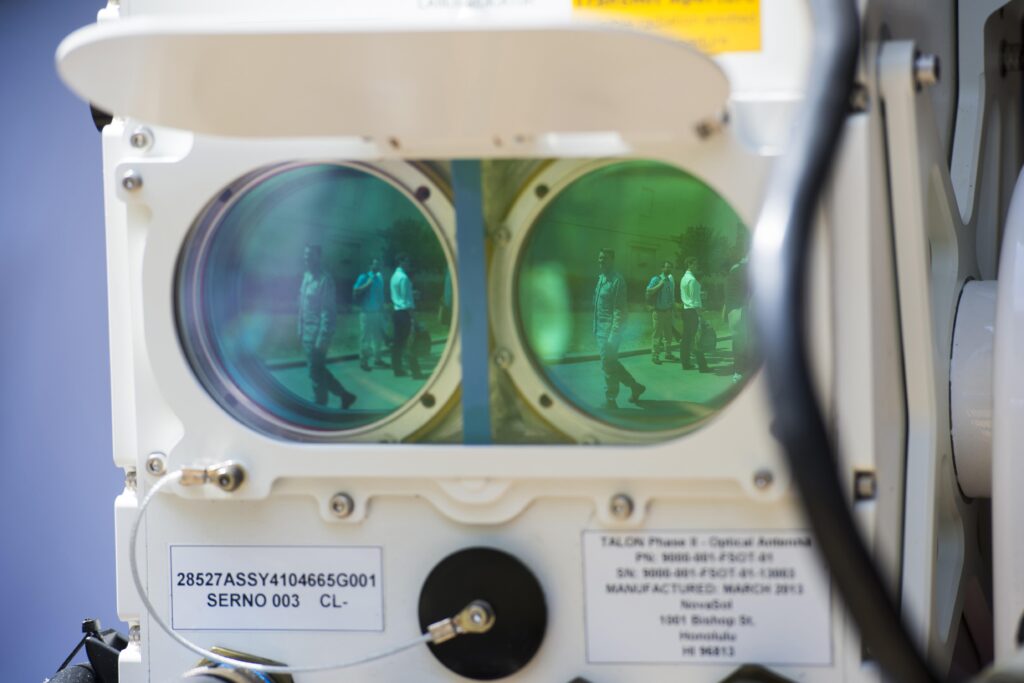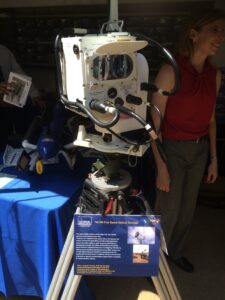Say It With Lasers: $45M DoD Prize For Optical Coms
Posted on

TALON laser communications device.
PENTAGON: Live by the radio, die by the radio — unless, maybe, you switch to lasers, which are much harder to detect and interfere with. That’s why the Defense Department recently awarded a three-year, $45 million grant to a tri-service project for a laser communications system.
“This is basically fiber optic communications without the fiber,” said lead researcher Linda Thomas, whose Naval Research Laboratory team takes home about a third of the grant money. Their TALON device transmits messages via laser over distances comparable to current Marine Corps tactical radios, but because it’s a narrow beam of light rather than a radio broadcast, it’s much harder for an enemy to pick up the transmission, let alone interfere with it. So while lasers can’t replace radios entirely, they provide a valuable alternative for vital battlefield communications.

Naval Research Laboratory researcher Linda Thomas (third from left) and collaborators receiving their $45 million ARAP prize.
Why does this matter so much? The modern US military relies on wireless networks and other radio-frequency communications to transmit orders, intelligence, and targeting data, but it’s increasingly anxious that advanced adversaries like Russia and China can detect those emissions, jam them, hack them, and triangulate their sources for bombardment, as the Ukrainian military learned with heavy losses in 2014. No less a figure than Army Chief of Staff Mark Milley has launched “a rigorous and painful review” of his service’s communications vulnerabilities, including flagship network WIN-T. One solution to the problem is to make wireless networks more robust, but another option is to avoid using radio waves entirely.
That’s where TALON comes in. (The contrived acronym stands for Tactical Line-of-sight Optical communications Network). Standing on display at the annual DoD lab day in the Pentagon courtyard — a kind of militarized science fair — it looks like an oversized version of the optical measurement devices you’ve probably seen surveyors using around your neighborhood: a big box with lenses, mounted on a tripod. Indeed, the basic concept of using lasers to send signals dates to the 1960s, Thomas told me, and you can buy “free space optical” communications gear today. (“Free space” refers to sending the light through the air, rather than through a fiber optic cable).
But commercial optical coms gear can only beam signals across short distances, at most about five miles (8 km). That’s useful for re-establishing communications after a natural disaster takes down cell towers, Thomas said, or getting a high-bandwidth relay over a short distance, say from a TV truck to a nearby news team. It’s not enough for maneuvering combat forces, especially with the Army and Marines‘ drive towards faster-moving, widely dispersed units.

TALON laser communications device (lead researcher Linda Thomas at right).
Thomas was cagey about the TALON system’s range, but it’s definitely more than five miles. In fact, the range is “up to 70 km” (43 miles), one Navy document says. To get that greater range, Thomas and her team had to solve complex optical problems involved in sending a low-power beam through atmospheric interference without becoming unintelligibly distorted. They also had to get widely separated TALON units to find each other and point their transmitters precisely at each others’ receivers. (Traditional radio doesn’t have this problem because it broadcasts its signal in all directions, but the whole point of laser communications is a narrow beam that’s hard to detect). Because heavy weather can still block laser beams, especially over long distances, Thomas emphasized you’d never want to get rid of your radios and rely exclusively on lasers.
One potential solution to the weather problem would be to lift the lasers out of the atmosphere entirely: There’s renewed interest in using communications lasers from satellites, an idea once thought dead with the cancelled TSAT program. (The lasers would still go through atmosphere to communicate to a ground unit, but transmitting straight up and down reduces the amount of thick low-altitude air you have to fight through). But laser satellites are a heavy lift, both literally in terms of launch capacity and figuratively in terms of funding.
Meanwhile, here on Earth, Thomas and her collaborators have moved past the research equipment displayed at the Pentagon and are building a full-up prototype. They expect to be done in about 20 months, she said, around New Year’s 2019.
Subscribe to our newsletter
Promotions, new products and sales. Directly to your inbox.
